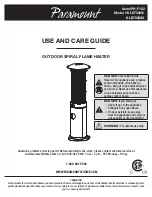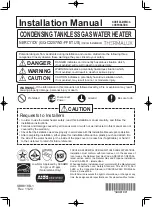
10
Operation
1
Pre-Operation
CAUTION:
Do not attempt to operate this appliance until you
have read and understand all Safety Information in this manual
and all assembly is complete and leak tests have been performed.
□
A dented, rusted or damaged propane cylinder may be hazardous
and should be checked by your cylinder supplier. Never use a
propane cylinder with a damaged valve connection.
□
The propane cylinder must be constructed and marked in
accordance with the specifications for LP gas cylinders of the US
Department of Transportation (DOT) or the standard for cylinders,
spheres and tubs for transportation of dangerous goods and
commission, CAN/CSA-B339.
□
The cylinder used must include a collar to protect the cylinder valve.
□
The cylinder must have a listed overfilling prevention device.
□
Do not store a spare LP gas cylinder under or near this appliance;
□
Never fill a cylinder beyond 80% full.
□
Place the dust cap on the cylinder valve outlet whenever the
cylinder is not in use. Only install the type of dust cap on the
cylinder valve that is provided with the cylinder valve. Other type
of caps or plugs may result in leakage of propane
□
Do not use indoors or inside any enclosure.
□
Retain the assembly instructions for future reference.
□
Installer — please leave these instructions with the owner.
Before Turning Gas Supply ON:
1. Your heater was designed and approved for OUTDOOR use only. Do
NOT use it inside a building, garage, or any other enclosed area.
2. Make sure surrounding areas are free of combustible materials,
gasoline, and other flammable vapors or liquids.
3. Ensure that there is no obstruction to air ventilation. Be sure all
gas connections are tight and there are no leaks.
4. Be sure the cylinder cover is clear of debris. Be sure any
component removed during assembly or servicing is replaced
and fastened prior to starting.
Before Lighting:
1. Heater should be thoroughly inspected before each use, and by
a qualified service person at least annually. If re-lighting a hot
heater, always wait at least 5 minutes.
2. Inspect the hose assembly for evidence of excessive abrasion,
cuts, or wear. Suspected areas should be leak tested. A leaky
must be replaced prior to operation. Only use the replacement
hose assembly specified by the manufacturer.
2
Peforming A Leak Test
WARNING:
□
Perform all leak tests outdoors.
□
NEVER leak test when smoking.
□
Extinguish all open flames. Never leak test with a match.
□
Do not use the appliance until all connections have
been leak tested and do not leak]
Make 2-3 oz. of leak test solution (one part liquid dishwashing
detergent and three parts water).
1. Apply several drops of solution where hose attaches to
regulator.
2. Apply several drops of solution where regulator connects to
cylinder.
3. Make sure all valves are turned OFF.
4. Turn cylinder valve ON.
If bubbles appear at any connection there is a leak.
1. Turn cylinder valve OFF.
2. If leak is at hose/regulator connection: tighten connection
and perform another leak test. If bubbles continue
appearing, the hose should be retuned to the place
of purchase or email [email protected] for
assistance.
3. If leak is at regulatory/cylinder valve connection:
disconnect, reconnect, and perform another leak test. If you
continue to see bubbles after several attempts, cylinder
valve is defective and should be returned to cylinder’s place
of purchase.
If NO bubbles appear at any connection, the connections are
secure.
NOTE:
Whenever gas connections are loosened or
removed, you must perform a complete leak test.


































